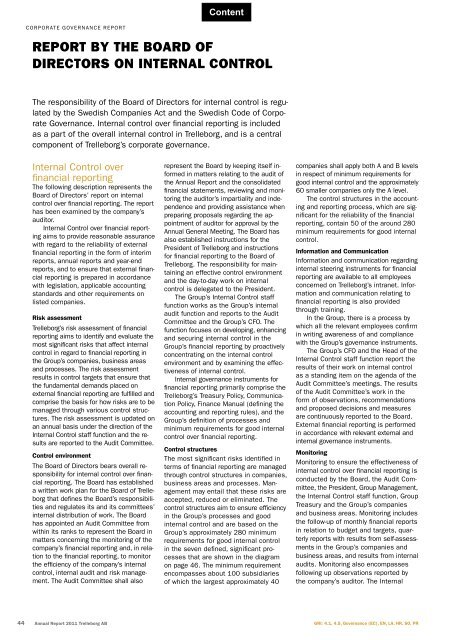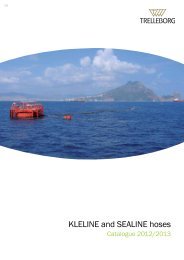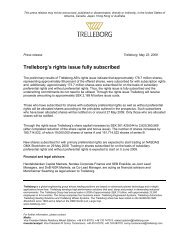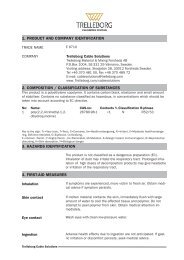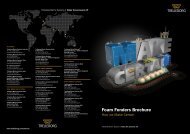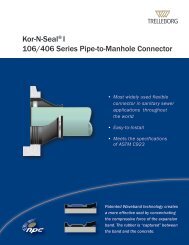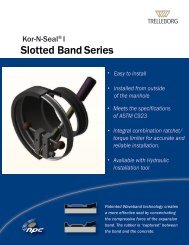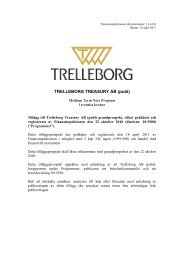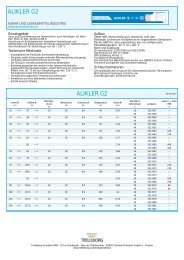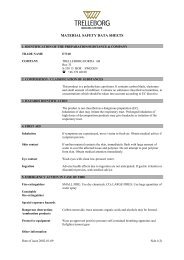Annual report 2011 - Trelleborg
Annual report 2011 - Trelleborg
Annual report 2011 - Trelleborg
Create successful ePaper yourself
Turn your PDF publications into a flip-book with our unique Google optimized e-Paper software.
CORPORATE GOVERNANCE REPORT<br />
REPORT BY THE BOARD OF<br />
DIRECTORS ON INTERNAL CONTROL<br />
The responsibility of the Board of Directors for internal control is regulated<br />
by the Swedish Companies Act and the Swedish Code of Corporate<br />
Governance. Internal control over financial <strong>report</strong>ing is included<br />
as a part of the overall internal control in <strong>Trelleborg</strong>, and is a central<br />
component of <strong>Trelleborg</strong>’s corporate governance.<br />
Internal Control over<br />
financial <strong>report</strong>ing<br />
The following description represents the<br />
Board of Directors’ <strong>report</strong> on internal<br />
control over financial <strong>report</strong>ing. The <strong>report</strong><br />
has been examined by the company’s<br />
auditor.<br />
Internal Control over financial <strong>report</strong>ing<br />
aims to provide reasonable assurance<br />
with regard to the reliability of external<br />
financial <strong>report</strong>ing in the form of interim<br />
<strong>report</strong>s, annual <strong>report</strong>s and year-end<br />
<strong>report</strong>s, and to ensure that external financial<br />
<strong>report</strong>ing is prepared in accordance<br />
with legislation, applicable accounting<br />
standards and other requirements on<br />
listed companies.<br />
Risk assessment<br />
<strong>Trelleborg</strong>’s risk assessment of financial<br />
<strong>report</strong>ing aims to identify and evaluate the<br />
most significant risks that affect internal<br />
control in regard to financial <strong>report</strong>ing in<br />
the Group’s companies, business areas<br />
and processes. The risk assessment<br />
results in control targets that ensure that<br />
the fundamental demands placed on<br />
external financial <strong>report</strong>ing are fulfilled and<br />
comprise the basis for how risks are to be<br />
managed through various control structures.<br />
The risk assessment is updated on<br />
an annual basis under the direction of the<br />
Internal Control staff function and the results<br />
are <strong>report</strong>ed to the Audit Committee.<br />
Control environment<br />
The Board of Directors bears overall responsibility<br />
for internal control over financial<br />
<strong>report</strong>ing. The Board has established<br />
a written work plan for the Board of <strong>Trelleborg</strong><br />
that defines the Board’s responsibilities<br />
and regulates its and its committees’<br />
internal distribution of work. The Board<br />
has appointed an Audit Committee from<br />
within its ranks to represent the Board in<br />
matters concerning the monitoring of the<br />
company’s financial <strong>report</strong>ing and, in relation<br />
to the financial <strong>report</strong>ing, to monitor<br />
the efficiency of the company’s internal<br />
control, internal audit and risk management.<br />
The Audit Committee shall also<br />
44 <strong>Annual</strong> Report <strong>2011</strong> <strong>Trelleborg</strong> AB<br />
represent the Board by keeping itself informed<br />
in matters relating to the audit of<br />
the <strong>Annual</strong> Report and the consolidated<br />
financial statements, reviewing and monitoring<br />
the auditor’s impartiality and independence<br />
and providing assistance when<br />
preparing proposals regarding the appointment<br />
of auditor for approval by the<br />
<strong>Annual</strong> General Meeting. The Board has<br />
also established instructions for the<br />
President of <strong>Trelleborg</strong> and instructions<br />
for financial <strong>report</strong>ing to the Board of<br />
<strong>Trelleborg</strong>. The responsibility for maintaining<br />
an effective control environment<br />
and the day-to-day work on internal<br />
control is delegated to the President.<br />
The Group’s Internal Control staff<br />
function works as the Group’s internal<br />
audit function and <strong>report</strong>s to the Audit<br />
Committee and the Group’s CFO. The<br />
function focuses on developing, enhancing<br />
and securing internal control in the<br />
Group’s financial <strong>report</strong>ing by proactively<br />
concentrating on the internal control<br />
environment and by examining the effectiveness<br />
of internal control.<br />
Internal governance instruments for<br />
financial <strong>report</strong>ing primarily comprise the<br />
<strong>Trelleborg</strong>’s Treasury Policy, Communication<br />
Policy, Finance Manual (defining the<br />
accounting and <strong>report</strong>ing rules), and the<br />
Group’s definition of processes and<br />
minimum requirements for good internal<br />
control over financial <strong>report</strong>ing.<br />
Control structures<br />
The most significant risks identified in<br />
terms of financial <strong>report</strong>ing are managed<br />
through control structures in companies,<br />
business areas and processes. Management<br />
may entail that these risks are<br />
accepted, reduced or eliminated. The<br />
control structures aim to ensure efficiency<br />
in the Group’s processes and good<br />
internal control and are based on the<br />
Group’s approximately 280 minimum<br />
requirements for good internal control<br />
in the seven defined, significant processes<br />
that are shown in the diagram<br />
on page 46. The minimum requirement<br />
encompasses about 100 subsidiaries<br />
of which the largest approximately 40<br />
companies shall apply both A and B levels<br />
in respect of minimum requirements for<br />
good internal control and the approximately<br />
60 smaller companies only the A level.<br />
The control structures in the accounting<br />
and <strong>report</strong>ing process, which are significant<br />
for the reliability of the financial<br />
<strong>report</strong>ing, contain 50 of the around 280<br />
minimum requirements for good internal<br />
control.<br />
Information and Communication<br />
Information and communication regarding<br />
internal steering instruments for financial<br />
<strong>report</strong>ing are available to all employees<br />
concerned on <strong>Trelleborg</strong>’s intranet. Information<br />
and communication relating to<br />
financial <strong>report</strong>ing is also provided<br />
through training.<br />
In the Group, there is a process by<br />
which all the relevant employees confirm<br />
in writing awareness of and compliance<br />
with the Group’s governance instruments.<br />
The Group’s CFO and the Head of the<br />
Internal Control staff function <strong>report</strong> the<br />
results of their work on internal control<br />
as a standing item on the agenda of the<br />
Audit Committee’s meetings. The results<br />
of the Audit Committee’s work in the<br />
form of observations, recommendations<br />
and proposed decisions and measures<br />
are continuously <strong>report</strong>ed to the Board.<br />
External financial <strong>report</strong>ing is performed<br />
in accordance with relevant external and<br />
internal governance instruments.<br />
Monitoring<br />
Monitoring to ensure the effectiveness of<br />
internal control over financial <strong>report</strong>ing is<br />
conducted by the Board, the Audit Committee,<br />
the President, Group Management,<br />
the Internal Control staff function, Group<br />
Treasury and the Group’s companies<br />
and business areas. Monitoring includes<br />
the follow-up of monthly financial <strong>report</strong>s<br />
in relation to budget and targets, quarterly<br />
<strong>report</strong>s with results from self-assessments<br />
in the Group’s companies and<br />
business areas, and results from internal<br />
audits. Monitoring also encompasses<br />
following up observations <strong>report</strong>ed by<br />
the company’s auditor. The Internal<br />
GRI: 4.1, 4.5, Governance (EC), EN, LA, HR, SO, PR


